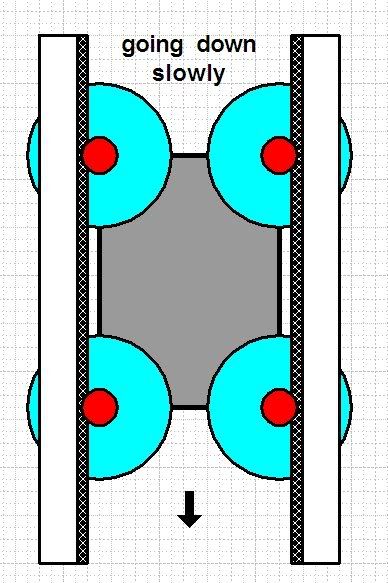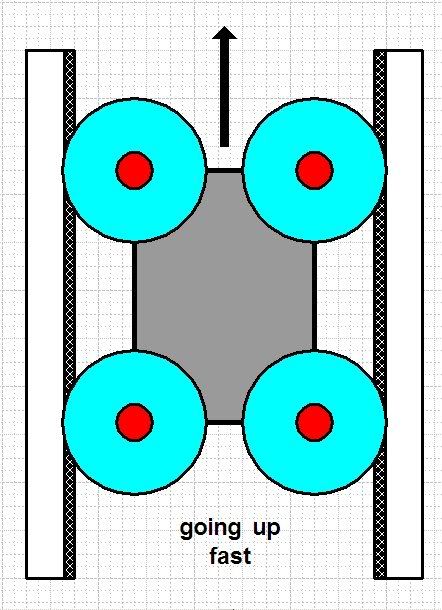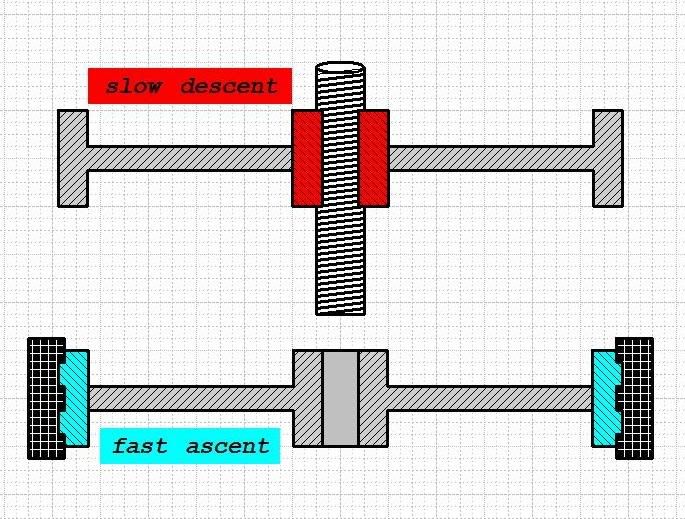Greetings my Fellow "Prisoners of Gravity..."
I've only just recently become interested in Bessler and the altogether intriguing topic of gravity wheels in general so you'll have to pardon any lack of sophistication or clumsiness in my own humble and well intentioned if not particularly well informed musings.
I was trying to find some additional input and information on what Abeling might be up to and what others who enjoy dwelling and speculating on such weighty matters might happen to think about it. According to the Great Google this place is right at the top ... so I figured I'd come here and maybe unload a bit and see which way things turn from there...hmmm?
It seems I have a slightly different and perhaps simpler take on Abeling's wheel that in all liklihood is probably just as useless as all the rest but "nothing ventured, nothing gained" as the old saying goes and any new bits to try and fit into any unsolved puzzle can at least help to more clearly focus on some of the edges and angles that do have to be eventually matched.
From my own primitive understanding of Abeling's version the weights are only "on the wheel" when they are in the notch at the end of their hcokey stick shaped slots on the outer edge of the wheel, which is roughly somewhere between 1 and 5 o'clock and pointed in the direction of the wheel's transit.
The rest of the time they are completely "off" and simply being pushed along the curving inclines of an outer track that is actually bearing the bulk of their weight while the general movement of the overall slot simply becomes a mechanism to apply the full force of the wheel and any weights currently dropping on it into assisting and maintainiing that weigh's own forward momentum as it rolls along that outside and somewhat eliptical track and forcefully back into to it's starting notch for another go.
So the weights aren't actually being "lifted" by the wheel in any way. That's only logical because it takes less enrgy to move them in that fashion as opposed to any other. As for the individual weights hopping on at 1 o'clock, that too seems be a far better spot to beigin the overbalancing than 12 or slightly after which is essentially a neutral position and actually creates more work for the wheel to turn them untill they get at least that far along to begin actually overbalancing the wheel.
Hopping off as it approaches 5 similarly reduces a drag that would otherwise begin there as the weight's own gravity is diverging from the wheel's own direction of travel and instead uses it for some useful momentum to help propel the weight on it's way as it rolls along it's own eliptical path rather than taking anything away from the wheel besides it's own weight and improving the wheel's trust from behind it, if anything.
It might actually be wiser to have another weight beginning to drop at exactly that point to make full use of that particular opportunity while helping the whell to more efficiently absorb whatever residual energy might otherwise be lost in it's impact.
Both of those features also greatly reduce the amount of vertical travel and distance the individual weights have to cover in order to return to their jumping-off point again.
As for how workable the idea actually is, I think it's important to consider the mass, motion, and momentum of the wheel with whatever weights are on it at any given moment vs. the mass, motion, and momentum of whatever rolling weights have to be pushed up and around their own outside track in order to hop back onto it as two very separate yet complimentary processes to get the real gyst of what's likely going to make it work if it can work at all.
Sort of like a "Drop Zone" ride at the amusement park that suddenly detaches before it hits the bottom and smoothly slides off onto a roller-coaster track almost straight down at first and then up through a looping hook that only requires a good crank from it's dropping counter-weight at the right moment and have the centrifical force it's path is forcing it into sling it the rest of the way round and back with a smack onto it's notch on the wheel to cycle once again.
Does any of that possibly make any sense to anyone?
Now Charles Campbell created an 8' wheel using ball weights that were either billiard balls or ball bearings about the same size as them that could, in fact, run under it's very own power based on pretty much the same idea of "on" and "off-loading" the balls around the same 1 and 5 o'clock positions as well, but his device was simply too unwieldy and with so many small balls in play over such large dimensions to turn it that after more than few minutes of steady operation the balls would be jumping and flying off at odd angles and points from their increasing spin just as soon as the wheel started to pick-up even the slightest bit of speed.
Mind you he still managed to get a respectable number of complete revolutions to prove the point that it could be done but had to abandon it to find some better set-up and way to apply it.
There are a number of critical ingredients as I see it but the more significant ones strike me as being that the slot has to be designed in such a way that it is only a contact point for pushing the weight from behind without unecessarily interfering or absorbing any of it's weight or energy while as large a portion of that weight and energy are being translated directly to carrying it along on that outside track and back to it's starting point.
The vids of an attempted replication of what Abeling's wheel can only be imagined to be along those lines and done working entirely from scratch, guesswork and what little information can be trusted at the moment looks reasonably promising.
Without a great deal of tinkering it's already capable of moving one very crudely mounted and slim, single rod shaped weight, well up over the wheel's centre solely from the pull of gravity on it's counterweight being gently released already in it's slot from the top. You can see the updates on that as it's being pursued here if you haven't already or recently...
http://peswiki.com/index.php/Directory: ... ower_Plant
Now whether that weight would have fared better if either it or the wheel or possibly both were heavier, or it rolled with a smoother action, a better optimized curve, or just possibly with some additional help from the either the wheel or maybe just a damn good shove to help overcome the wheel's latent inertia and get it to some kind of "take-off speed" which it most likly has, all remain to be seen.
My question is whether or not any of those tantalizing propositions could be the answer or enhanced sufficiently to do what what I've suggested or does they stimulate any sparks towards some alternative propositions that might also be able to make some use of any of them?





 )
)
